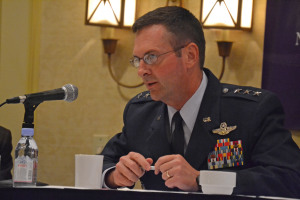
National Guard Bureau Vice Chief Lt. Gen. Joseph L. Lengyel
National Guard Bureau Vice Chief Lt. Gen. Joseph L. Lengyel offered a list of interesting and important facts to help journalists get better acquainted with the National Guard during an Oct. 1 panel discussion in Washington.
The panel, which brought together Lengyel and United States Army Reserve Commanding General Lt. Gen. Jeffrey W. Talley to discuss the future of the National Guard and Army Reserve, was held as part of “Covering the Military, Veterans and Homeland Security: Tomorrow’s Trends and Issues,” the Medill National Security Journalism Initiative’s 2014 conference.
For those not in the National-Guard know, here’s the lowdown:
- It’s a Sagittarius. According to Lengyel, the National Guard is recognized as having been born on Dec. 13, 1636. From its founding until 1903, he says, the Guard was essentially an informal militia. At the end of the 19th century, though, the government decided to regulate and standardize it, at which point training became federally funded. “It took us a while to get there, but we became that strategic reserve force,” he says.
- Members of the National Guard are sworn to uphold two constitutions: that of the United States and that of their respective states. They also swear to obey orders handed down by the governors of these states. Lengyel said it makes the Guard “distinctly different” from the Army Reserve and has inspired people to refer to it as a “dual-use force.”
- But what if the states don’t agree with the country? Not to worry. Lengyel said that state governors cannot command National Guard troops to defy the U.S. Constitution.
- They can get deployed in three ways.
- Title 10: When National Guard troops are funded under Title 10, they are working under the auspices of the federal government (read: holding up the U.S. Constitution side of their duty) and are being trained, mobilized and equipped to go to war.
- Title 32: When National Guard troops are funded under Title 32, they are working under a state governor’s control, but in homeland public status and with ties to the Pentagon. In such cases, since government funds are still used, the Pentagon still has partial control of the kinds of duties these troops can carry out.
- State Active Duty: When the National Guard is deployed in this manner within a state, the units are referred to as [Insert-state-name-here] National Guard to clearly delineate that they’re working under the state governor’s command. In these cases, the governor in question cover the cost of guard training and service with state funds, and they reimburse the federal government for the use of any military equipment utilized. Lengyel cited state National Guard deployments in Ferguson, Mo., and along the U.S.-Mexico border in Texas as more prominent examples of this.
- Its air capabilities can go toe-to-toe with those of active-duty units. Lengyel said that Air Force Chief of Staff Gen. Mark A. Welsh III recently told him that, when looking for a fighter squadron to deploy, he didn’t actively distinguish between active or reserve elements or cite any mobilization limitations (save for requisite pre-deployment Title 10 training). “On the air side of the National Guard, our readiness is equal to the active component,” he said. “There’s no difference.”
- The same can’t be said for the National Guard’s ground capabilities, but there’s a reason for that. “We’re designed to maintain a normal level of readiness until they decide they’re going to send us to war, and then they mobilize us, train us and send us,” Lengyel explained. “We are not funded or designed to be at the same level of readiness as our active-duty brothers and sisters.”
- The Guard has three big jobs: to make sure troops are always ready to deploy to support the Army and Air Force, to be on call to assist the homeland at state governors’ behests and to aid in state partnerships between the U.S. and other nations via things like training with their militaries.
- Regardless, the Guard is huge, and it’s ready to defend you. “It’s a big organization,” Lengyel said. “It’s never been more ready. It’s never been more flexible. It’s never been more used than over the past 15 years.” He says it has more force utilization and better equipment, readiness and training than ever before, and that since 9/11, it along with other military reserves have become an operating force. But he’s worried that budget cutbacks could make these duties harder to accomplish.





